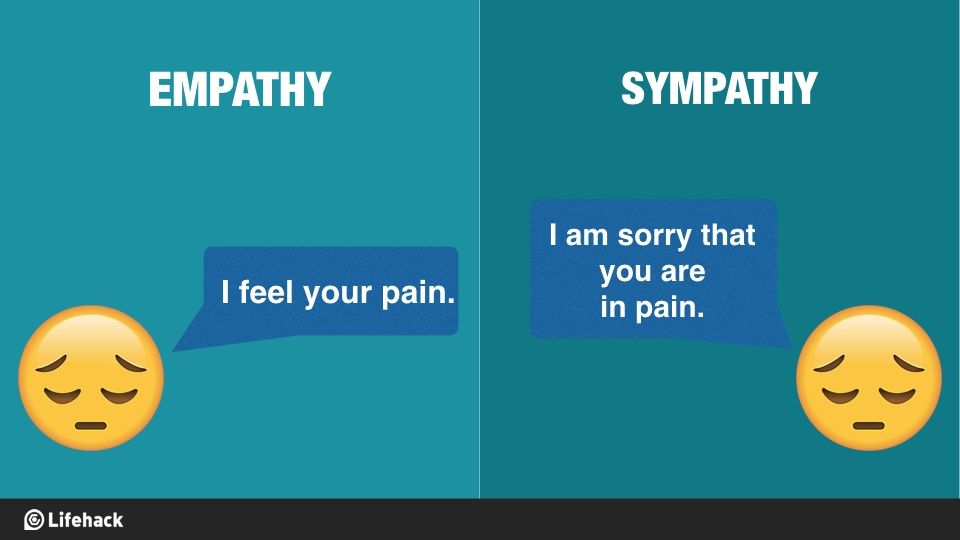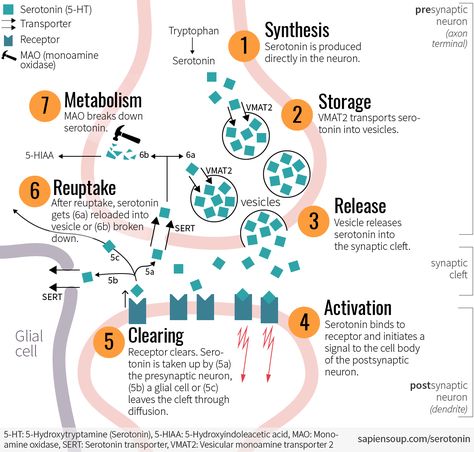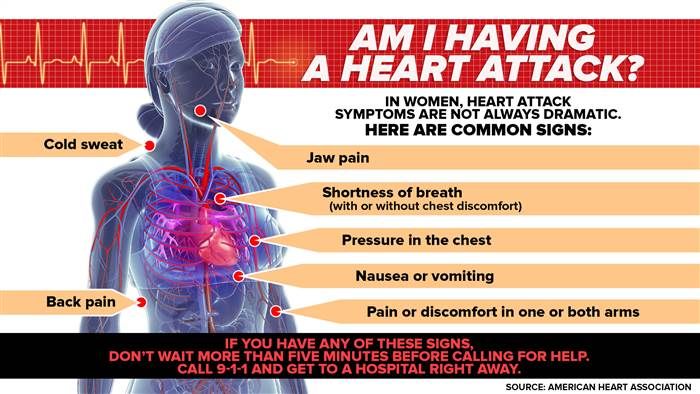Personality disorder trait
Types, Causes, Symptoms & Treatment
Overview
What is a personality disorder?
A personality disorder is a mental health condition that involves long-lasting, all-encompassing, disruptive patterns of thinking, behavior, mood and relating to others. These patterns cause a person significant distress and/or impair their ability to function.
There are 10 types of personality disorders, each with different characteristics and symptoms.
Personality is vital to defining who we are as individuals. It involves a unique blend of traits — including attitudes, thoughts and behaviors — as well as how we express these traits in our interactions with others and with the world around us.
Personality disorders may cause distorted perceptions of reality, abnormal behaviors and distress across various aspects of life, including work, relationships and social functioning. Additionally, people with a personality disorder may not recognize their troubling behaviors or the negative effect they have on others.
What are the types of personality disorders?
The Diagnostic and Statistical Manual of Mental Disorders (DSM-5), which is the standard reference publication for recognized mental illnesses, organizes the 10 types of personality disorders into three main clusters (categories). Each cluster has different symptoms in common.
Cluster A personality disorders
Cluster A personality disorders involve unusual and eccentric thinking or behaviors. These include:
- Paranoid personality disorder: The main feature of this condition is paranoia, which is a relentless mistrust and suspicion of others without adequate reason for suspicion. People with paranoid personality disorder often believe others are trying to demean, harm or threaten them.
- Schizoid personality disorder: This condition is marked by a consistent pattern of detachment from and general disinterest in interpersonal relationships. People with schizoid personality disorder have a limited range of emotions when interacting with others.
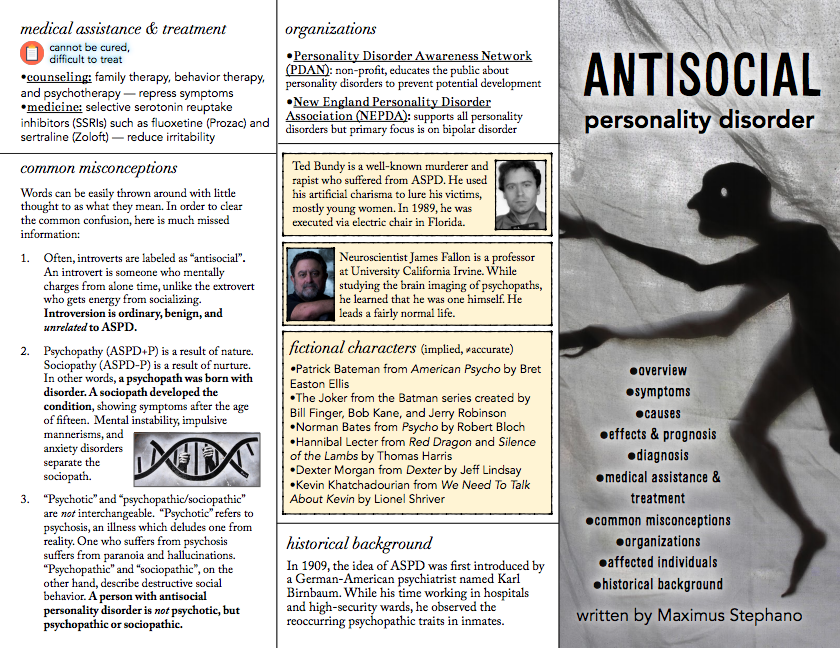
- Schizotypal personality disorder: People with this condition display a consistent pattern of intense discomfort with and limited need for close relationships. Relationships may be hindered by their distorted views of reality, superstitions and unusual behaviors.
Cluster B personality disorders
Cluster B personality disorders involve dramatic and erratic behaviors. People with these types of conditions display intense, unstable emotions and impulsive behaviors. Cluster B personality disorders include:
- Antisocial personality disorder (ASPD): People with ASPD show a lack of respect toward others and don’t follow socially accepted norms or rules. People with ASPD may break the law or cause physical or emotional harm to others around them. They may refuse to take responsibility for their behaviors and/or display disregard for the negative consequences of their actions.
- Borderline personality disorder (BPD): This condition is marked by difficulty with emotional regulation, resulting in low self-esteem, mood swings, impulsive behaviors and subsequent relationship difficulties.
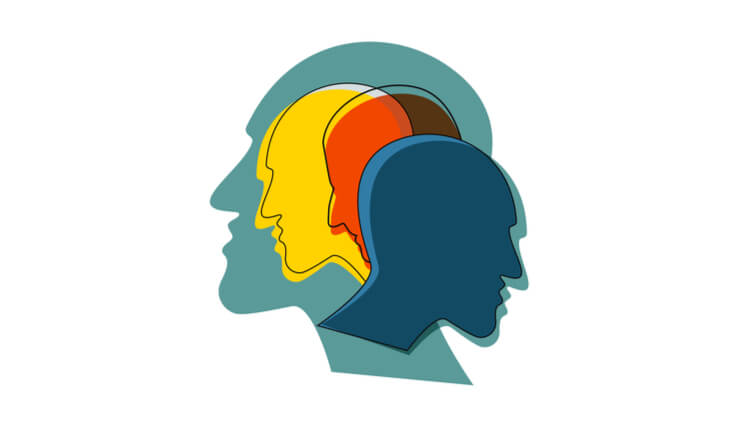
- Histrionic personality disorder: This condition is marked by intense, unstable emotions and a distorted self-image. For people with histrionic personality disorder, their self-esteem depends on the approval of others and doesn’t come from a true feeling of self-worth. They have an overwhelming desire to be noticed by others, and may display dramatic and/or inappropriate behaviors to get attention.
- Narcissistic personality disorder: This condition involves a consistent pattern of perceived superiority and grandiosity, an excessive need for praise and admiration and a lack of empathy for others. These thoughts and behaviors often stem from low self-esteem and a lack of self-confidence.
Cluster C personality disorders
Cluster C personality disorders involve severe anxiety and fear. They include:
- Avoidant personality disorder: People with this condition have chronic feelings of inadequacy and are highly sensitive to being negatively judged by others.
 Though they would like to interact with others, they tend to avoid social interaction due to the intense fear of being rejected.
Though they would like to interact with others, they tend to avoid social interaction due to the intense fear of being rejected. - Dependent personality disorder: This condition is marked by a constant and excessive need to be cared for by someone else. It also involves submissiveness, a need for constant reassurance and the inability to make decisions. People with dependent personality disorder often become very close to another person and spend great effort trying to please that person. They tend to display passive and clinging behavior and have a fear of separation.
- Obsessive-compulsive personality disorder (OCPD) : This condition is marked by a consistent and extreme need for orderliness, perfectionism and control (with no room for flexibility) that ultimately slows or interferes with completing a task. It can also interfere with relationships.
This is a separate condition from obsessive-compulsive disorder (OCD), which is classified as an anxiety disorder. While people with OCD usually are aware that OCD is causing their behavior and accept they need to change, people with OCPD usually have little, if any, self-awareness of their behaviors.
While people with OCD usually are aware that OCD is causing their behavior and accept they need to change, people with OCPD usually have little, if any, self-awareness of their behaviors.
People might have mixed symptoms of more than one personality disorder.
Who do personality disorders affect?
Anyone can have a personality disorder. But different types of personality disorders affect people differently.
Most personality disorders begin in the teen years when your personality further develops and matures. As a result, almost all people diagnosed with personality disorders are above the age of 18. One exception to this is antisocial personality disorder — approximately 80% of people with this disorder will have started to show symptoms by the age of 11.
Antisocial personality disorders are more likely to affect people assigned male at birth. Borderline, histrionic and dependent personality disorders are more likely to affect people assigned female at birth.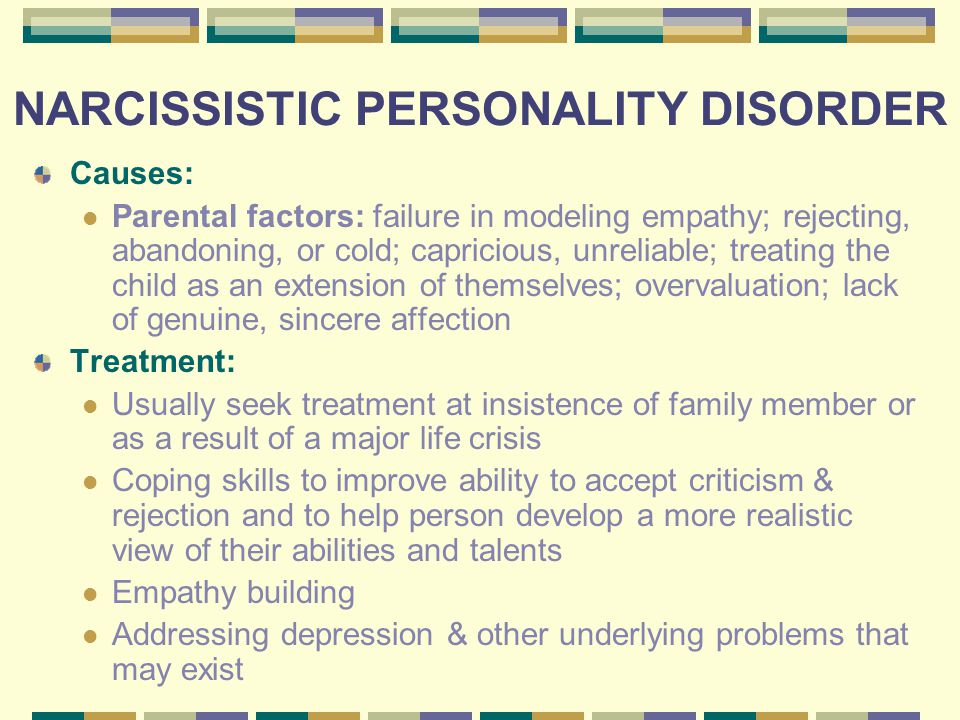
How common are personality disorders?
Approximately 9% of adults in the U.S. have some type of personality disorder, and about 6% of the global population has a personality disorder.
Borderline personality disorder (BPD) and antisocial personality disorder are the most frequently diagnosed personality disorders.
Symptoms and Causes
What causes personality disorders?
Personality disorders are among the least understood mental health conditions. Scientists are still trying to figure out the cause of them.
So far, they believe the following factors may contribute to the development of personality disorders:
- Genetics: Scientists have identified a malfunctioning gene that may be a factor in obsessive-compulsive personality disorder. Researchers are also exploring genetic links to aggression, anxiety and fear, which are traits that can play a role in personality disorders.
- Brain changes: Researchers have identified subtle brain differences in people with certain personality disorders.
 For example, findings in studies on paranoid personality disorder point to altered amygdala functioning. The amygdala is the part of your brain that’s involved with processing fearful and threatening stimuli. In a study on schizotypal personality disorder, researchers found a volumetric decrease in the frontal lobe of their brain.
For example, findings in studies on paranoid personality disorder point to altered amygdala functioning. The amygdala is the part of your brain that’s involved with processing fearful and threatening stimuli. In a study on schizotypal personality disorder, researchers found a volumetric decrease in the frontal lobe of their brain. - Childhood trauma: One study revealed a link between childhood traumas and the development of personality disorders. People with borderline personality disorder, for example, had especially high rates of childhood sexual trauma. People with borderline and antisocial personality disorders have issues with intimacy and trust, both of which may be related to childhood abuse and trauma.
- Verbal abuse: In one study, people who experienced verbal abuse as children were three times as likely to have borderline, narcissistic, obsessive-compulsive or paranoid personality disorders in adulthood.
- Cultural factors: Cultural factors may also play a role in the development of personality disorders, as demonstrated by the varying rates of personality disorders between different countries.
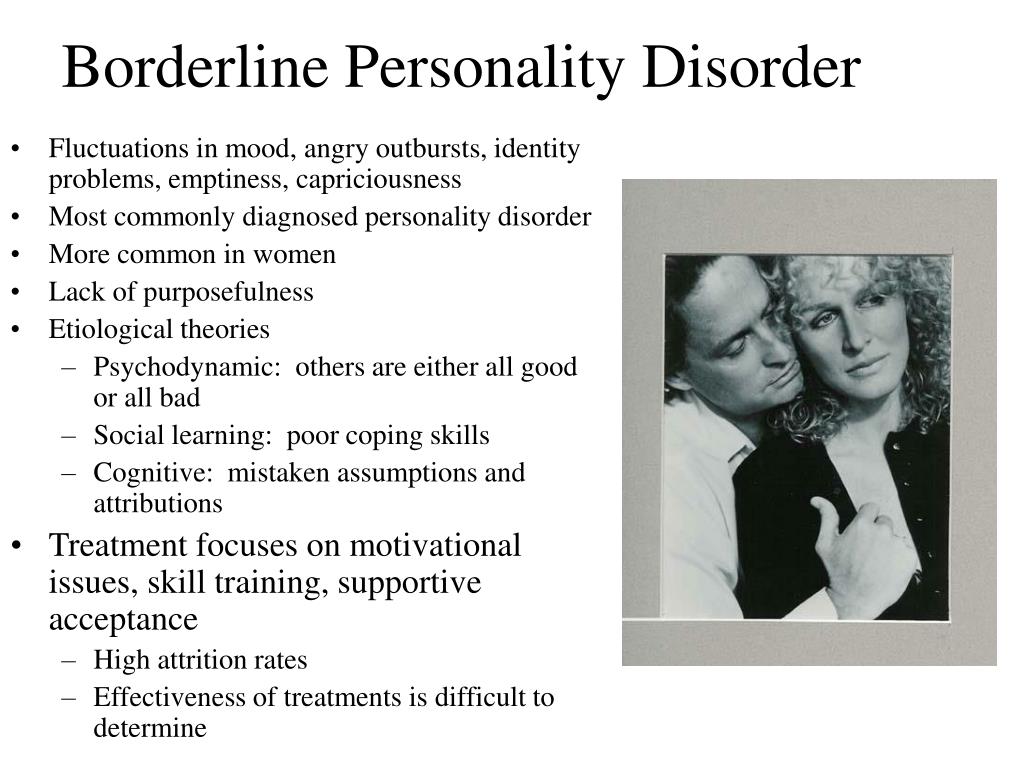 For example, there are remarkably low cases of antisocial personality disorders in Taiwan, China and Japan, along with significantly higher rates of cluster C personality disorders.
For example, there are remarkably low cases of antisocial personality disorders in Taiwan, China and Japan, along with significantly higher rates of cluster C personality disorders.
What are the symptoms of personality disorders?
Each of the 10 types of personality disorders has its own specific signs and symptoms.
But, in general, personality disorders involve problems with:
- Identity and a sense of self: People with a personality disorder generally lack a clear or stable image of themselves, and how they see themselves often changes depending on the situation or the people they’re with. Their self-esteem may be unrealistically high or low.
- Relationships: People with a personality disorder struggle to form close, stable relationships with others due to their problematic beliefs and behaviors. They may lack empathy or respect for others, be emotionally detached or be overly needy of attention and care.
Another distinguishing sign of personality disorders is that most people who have one often have little to no insight or self-awareness of how their thoughts and behaviors are problematic.
How do you know if someone has a personality disorder?
You can’t know for sure if someone has a personality disorder unless they receive a professional, medical diagnosis.
It’s important to understand the difference between personality types and personality disorders. A person who is shy or likes to spend time alone doesn’t necessarily have an avoidant or schizoid personality disorder.
The difference between personality style and a personality disorder can often be determined by assessing how the person’s personality affects different parts of their life, including:
- Work.
- Relationships.
- Feelings/emotions.
- Self-identity.
- Awareness of reality.
- Behavior and impulse control.
Some general signs of people with a personality disorder include:
- Their behavior is inconsistent, frustrating and confusing to loved ones and other people they interact with.
- They may have issues understanding realistic and acceptable ways to treat others and behave around them.

- They may be unaware of how their behaviors cause problems for themselves and/or others.
- If they’re a parent, their parenting style may be detached, overemotional, abusive or irresponsible. This can sometimes lead to physical, emotional or mental issues in their children.
Diagnosis and Tests
How are personality disorders diagnosed?
Personality disorders can be difficult to diagnose since most people with a personality disorder don’t think there’s a problem with their behavior or way of thinking.
Because of this, people with a personality disorder typically don’t seek help or a diagnosis for their condition. Instead, their loved ones or a social agency may refer them to a mental health professional because their behavior causes difficulty for others.
When they do seek help, it’s often due to conditions such as anxiety, depression or substance use, or because of the problems created by their personality disorder, such as divorce or unemployment, not the disorder itself.
Healthcare providers base the diagnosis of a specific personality disorder on criteria provided in the American Psychiatric Association’s Diagnostic and Statistical Manual of Mental Disorders.
When a mental health professional, like a psychologist or psychiatrist, suspects someone might have a personality disorder, they often ask broad, general questions that won’t create a defensive response or hostile environment. They ask questions that will shed light on:
- Past history.
- Relationships
- Previous work history.
- Reality testing.
- Impulse control.
Because a person suspected of having a personality disorder may lack insight into their behaviors, mental health professionals often work with the person’s family, friends and/or parole officers to collect more insight about their behaviors and history.
Personality disorders are generally underdiagnosed because providers sometimes focus on the symptoms of anxiety or depression, which are much more common in the general population than personality disorders. These symptoms may overshadow the features of any underlying personality disorder.
These symptoms may overshadow the features of any underlying personality disorder.
Management and Treatment
How are personality disorders treated?
Personality disorders are some of the most difficult disorders to treat in psychiatry. This is mainly because people with personality disorders don’t think their behavior is problematic, so they don’t often seek treatment.
And even if a person with a personality disorder seeks treatment, modern medicine is still lacking in available treatment options — there are no medications currently approved to treat any personality disorder. But there are medications that can help with symptoms of anxiety and depression, which are common in people with a personality disorder.
But psychotherapy (talk therapy) can help manage personality disorders. Psychotherapy is a term for a variety of treatment techniques that aim to help you identify and change troubling emotions, thoughts and behaviors. Working with a mental health professional, like a psychologist or psychiatrist, can provide support, education and guidance to you and your family.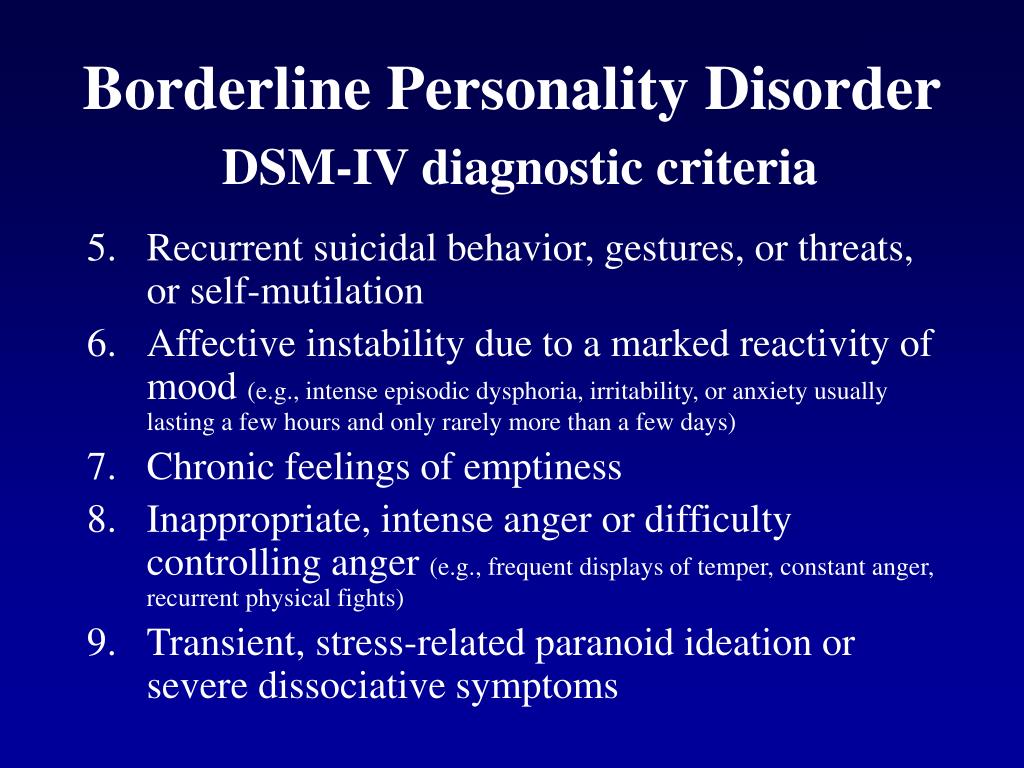
The main goals of psychotherapy for treating personality disorders include:
- Reducing immediate distress, such as anxiety and depression.
- Helping the person understand that their problems are internal and not caused by other people or situations.
- Decreasing unhealthy and socially undesirable behavior.
- Modifying the personality traits that are causing difficulties.
There are several different types of psychotherapy, and each personality disorder requires different types.
For example, studies show that dialectical behavior therapy (DBT) is effective for treating those with borderline personality disorder, and people with histrionic personality disorder often benefit from cognitive-behavioral therapy (CBT).
Prevention
Can personality disorders be prevented?
At this time, there’s no known way to prevent personality disorders, but many of the related problems might be lessened with treatment. Seeking help as soon as symptoms appear can help decrease the disruption to the person’s life, family and friendships.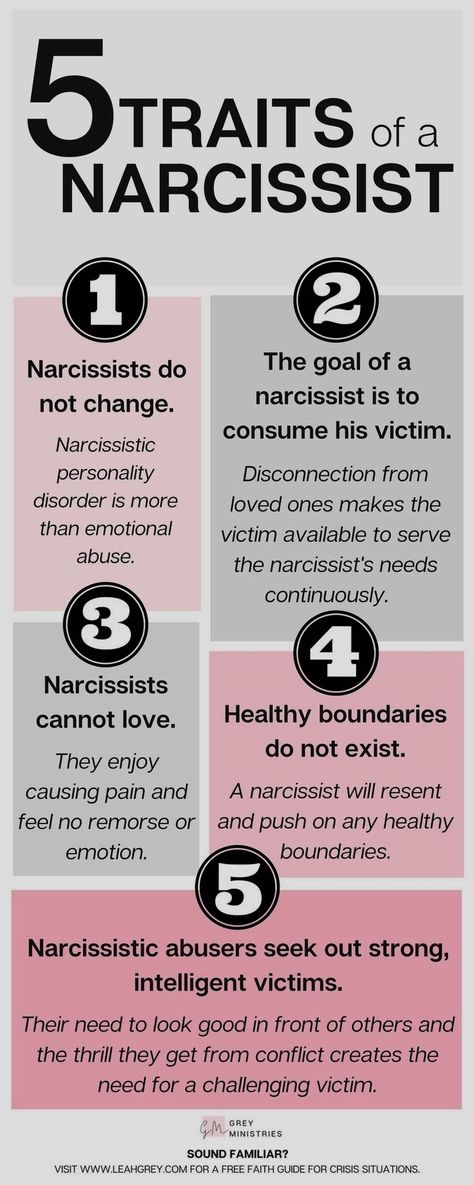
Outlook / Prognosis
What is the prognosis (outlook) for personality disorders?
Since people with personality disorders often don’t seek proper medical attention, the overall prognosis for personality disorders is poor.
Untreated personality disorders may result in:
- Poor relationships.
- Occupational difficulties.
- Impaired social functioning.
Studies show that personality disorders are associated with elevated rates of:
- Unemployment.
- Divorce.
- Domestic abuse.
- Substance use.
- Homelessness.
- Crime (especially antisocial personality disorder).
In addition, people with personality disorders are more likely to visit the emergency room (ER), experience traumatic accidents and have early deaths by suicide.
Although the outlook is dire, studies show that collaborative care management can greatly improve outcomes for people with personality disorders if they stay committed to treatment.
If you know someone who has or may have a personality disorder, try to persuade them to seek treatment. It’s also important to educate yourself about the nature of the specific personality disorder so you can better understand what to expect.
A note from Cleveland Clinic
It’s important to remember that personality disorders are mental health conditions. As with all mental health conditions, seeking help as soon as symptoms appear can help decrease the disruptions to your life. Mental health professionals can offer treatment plans that can help you manage your thoughts and behaviors.
The family members of people with personality disorders often experience stress, depression, grief and isolation. It’s important to take care of your mental health and seek help if you’re experiencing these symptoms.
Personality disorders - Symptoms and causes
Overview
A personality disorder is a type of mental disorder in which you have a rigid and unhealthy pattern of thinking, functioning and behaving. A person with a personality disorder has trouble perceiving and relating to situations and people. This causes significant problems and limitations in relationships, social activities, work and school.
A person with a personality disorder has trouble perceiving and relating to situations and people. This causes significant problems and limitations in relationships, social activities, work and school.
In some cases, you may not realize that you have a personality disorder because your way of thinking and behaving seems natural to you. And you may blame others for the challenges you face.
Personality disorders usually begin in the teenage years or early adulthood. There are many types of personality disorders. Some types may become less obvious throughout middle age.
Products & Services
- Book: Mayo Clinic Family Health Book, 5th Edition
- Newsletter: Mayo Clinic Health Letter — Digital Edition
Symptoms
Types of personality disorders are grouped into three clusters, based on similar characteristics and symptoms. Many people with one personality disorder also have signs and symptoms of at least one additional personality disorder.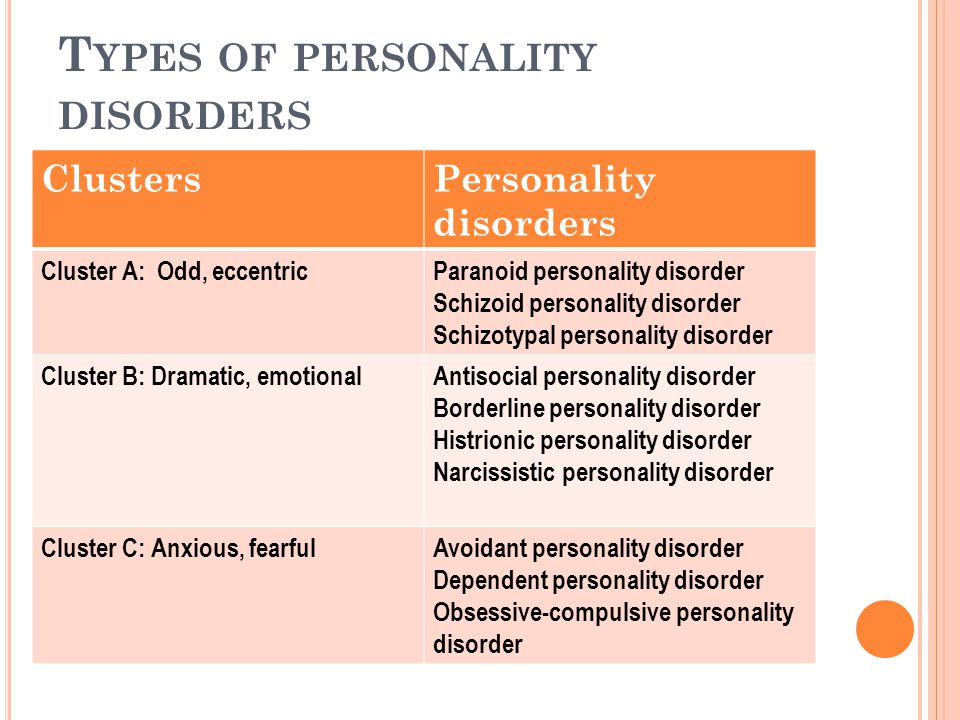 It's not necessary to exhibit all the signs and symptoms listed for a disorder to be diagnosed.
It's not necessary to exhibit all the signs and symptoms listed for a disorder to be diagnosed.
Cluster A personality disorders
Cluster A personality disorders are characterized by odd, eccentric thinking or behavior. They include paranoid personality disorder, schizoid personality disorder and schizotypal personality disorder.
Paranoid personality disorder
- Pervasive distrust and suspicion of others and their motives
- Unjustified belief that others are trying to harm or deceive you
- Unjustified suspicion of the loyalty or trustworthiness of others
- Hesitancy to confide in others due to unreasonable fear that others will use the information against you
- Perception of innocent remarks or nonthreatening situations as personal insults or attacks
- Angry or hostile reaction to perceived slights or insults
- Tendency to hold grudges
- Unjustified, recurrent suspicion that spouse or sexual partner is unfaithful
Schizoid personality disorder
- Lack of interest in social or personal relationships, preferring to be alone
- Limited range of emotional expression
- Inability to take pleasure in most activities
- Inability to pick up normal social cues
- Appearance of being cold or indifferent to others
- Little or no interest in having sex with another person
Schizotypal personality disorder
- Peculiar dress, thinking, beliefs, speech or behavior
- Odd perceptual experiences, such as hearing a voice whisper your name
- Flat emotions or inappropriate emotional responses
- Social anxiety and a lack of or discomfort with close relationships
- Indifferent, inappropriate or suspicious response to others
- "Magical thinking" — believing you can influence people and events with your thoughts
- Belief that certain casual incidents or events have hidden messages meant only for you
Cluster B personality disorders
Cluster B personality disorders are characterized by dramatic, overly emotional or unpredictable thinking or behavior.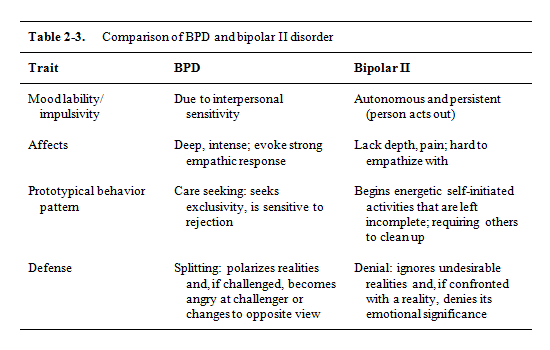 They include antisocial personality disorder, borderline personality disorder, histrionic personality disorder and narcissistic personality disorder.
They include antisocial personality disorder, borderline personality disorder, histrionic personality disorder and narcissistic personality disorder.
Antisocial personality disorder
- Disregard for others' needs or feelings
- Persistent lying, stealing, using aliases, conning others
- Recurring problems with the law
- Repeated violation of the rights of others
- Aggressive, often violent behavior
- Disregard for the safety of self or others
- Impulsive behavior
- Consistently irresponsible
- Lack of remorse for behavior
Borderline personality disorder
- Impulsive and risky behavior, such as having unsafe sex, gambling or binge eating
- Unstable or fragile self-image
- Unstable and intense relationships
- Up and down moods, often as a reaction to interpersonal stress
- Suicidal behavior or threats of self-injury
- Intense fear of being alone or abandoned
- Ongoing feelings of emptiness
- Frequent, intense displays of anger
- Stress-related paranoia that comes and goes
Histrionic personality disorder
- Constantly seeking attention
- Excessively emotional, dramatic or sexually provocative to gain attention
- Speaks dramatically with strong opinions, but few facts or details to back them up
- Easily influenced by others
- Shallow, rapidly changing emotions
- Excessive concern with physical appearance
- Thinks relationships with others are closer than they really are
Narcissistic personality disorder
- Belief that you're special and more important than others
- Fantasies about power, success and attractiveness
- Failure to recognize others' needs and feelings
- Exaggeration of achievements or talents
- Expectation of constant praise and admiration
- Arrogance
- Unreasonable expectations of favors and advantages, often taking advantage of others
- Envy of others or belief that others envy you
Cluster C personality disorders
Cluster C personality disorders are characterized by anxious, fearful thinking or behavior.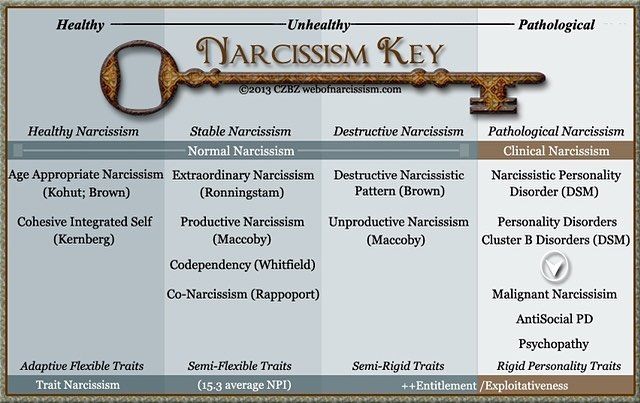 They include avoidant personality disorder, dependent personality disorder and obsessive-compulsive personality disorder.
They include avoidant personality disorder, dependent personality disorder and obsessive-compulsive personality disorder.
Avoidant personality disorder
- Too sensitive to criticism or rejection
- Feeling inadequate, inferior or unattractive
- Avoidance of work activities that require interpersonal contact
- Socially inhibited, timid and isolated, avoiding new activities or meeting strangers
- Extreme shyness in social situations and personal relationships
- Fear of disapproval, embarrassment or ridicule
Dependent personality disorder
- Excessive dependence on others and feeling the need to be taken care of
- Submissive or clingy behavior toward others
- Fear of having to provide self-care or fend for yourself if left alone
- Lack of self-confidence, requiring excessive advice and reassurance from others to make even small decisions
- Difficulty starting or doing projects on your own due to lack of self-confidence
- Difficulty disagreeing with others, fearing disapproval
- Tolerance of poor or abusive treatment, even when other options are available
- Urgent need to start a new relationship when a close one has ended
Obsessive-compulsive personality disorder
- Preoccupation with details, orderliness and rules
- Extreme perfectionism, resulting in dysfunction and distress when perfection is not achieved, such as feeling unable to finish a project because you don't meet your own strict standards
- Desire to be in control of people, tasks and situations, and inability to delegate tasks
- Neglect of friends and enjoyable activities because of excessive commitment to work or a project
- Inability to discard broken or worthless objects
- Rigid and stubborn
- Inflexible about morality, ethics or values
- Tight, miserly control over budgeting and spending money
Obsessive-compulsive personality disorder is not the same as obsessive-compulsive disorder, a type of anxiety disorder.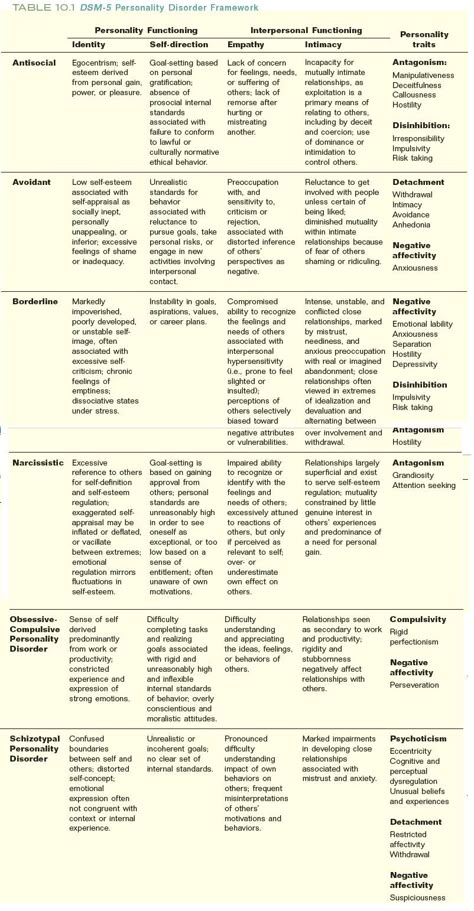
When to see a doctor
If you have any signs or symptoms of a personality disorder, see your doctor or other primary care professional or a mental health professional. Untreated, personality disorders can cause significant problems in your life that may get worse without treatment.
Request an Appointment at Mayo Clinic
From Mayo Clinic to your inbox
Sign up for free, and stay up to date on research advancements, health tips and current health topics, like COVID-19, plus expertise on managing health.
To provide you with the most relevant and helpful information, and understand which
information is beneficial, we may combine your email and website usage information with
other information we have about you. If you are a Mayo Clinic patient, this could
include protected health information. If we combine this information with your protected
health information, we will treat all of that information as protected health
information and will only use or disclose that information as set forth in our notice of
privacy practices.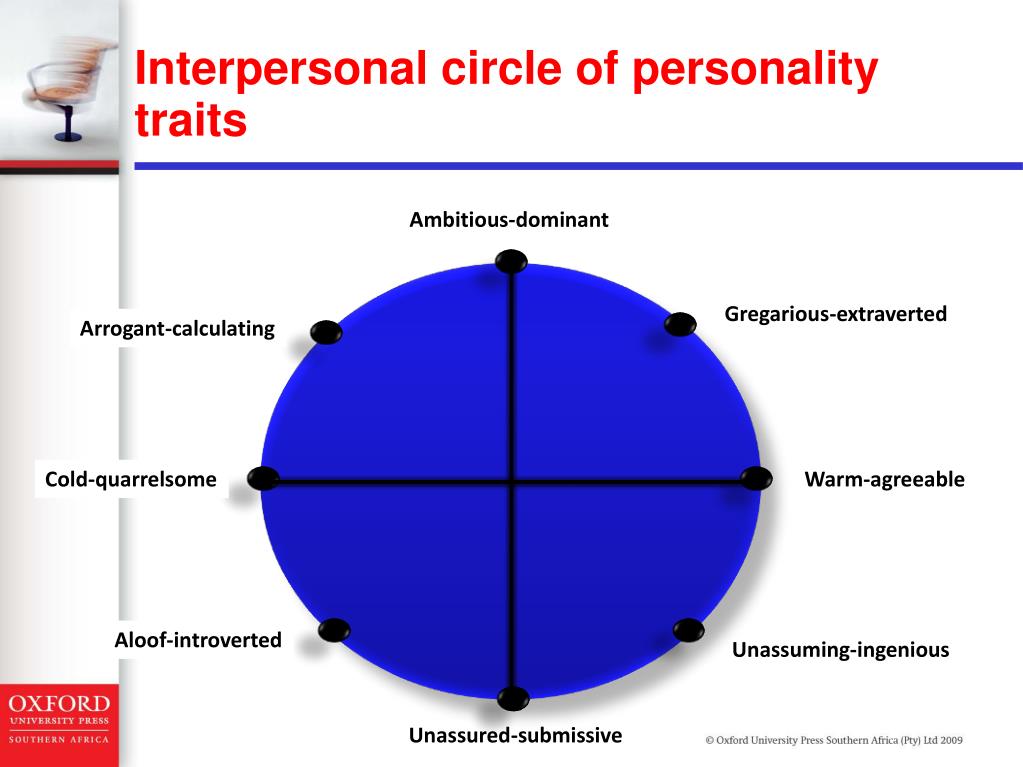 You may opt-out of email communications at any time by clicking on
the unsubscribe link in the e-mail.
You may opt-out of email communications at any time by clicking on
the unsubscribe link in the e-mail.
Causes
Personality is the combination of thoughts, emotions and behaviors that makes you unique. It's the way you view, understand and relate to the outside world, as well as how you see yourself. Personality forms during childhood, shaped through an interaction of:
- Your genes. Certain personality traits may be passed on to you by your parents through inherited genes. These traits are sometimes called your temperament.
- Your environment. This involves the surroundings you grew up in, events that occurred, and relationships with family members and others.
Personality disorders are thought to be caused by a combination of these genetic and environmental influences. Your genes may make you vulnerable to developing a personality disorder, and a life situation may trigger the actual development.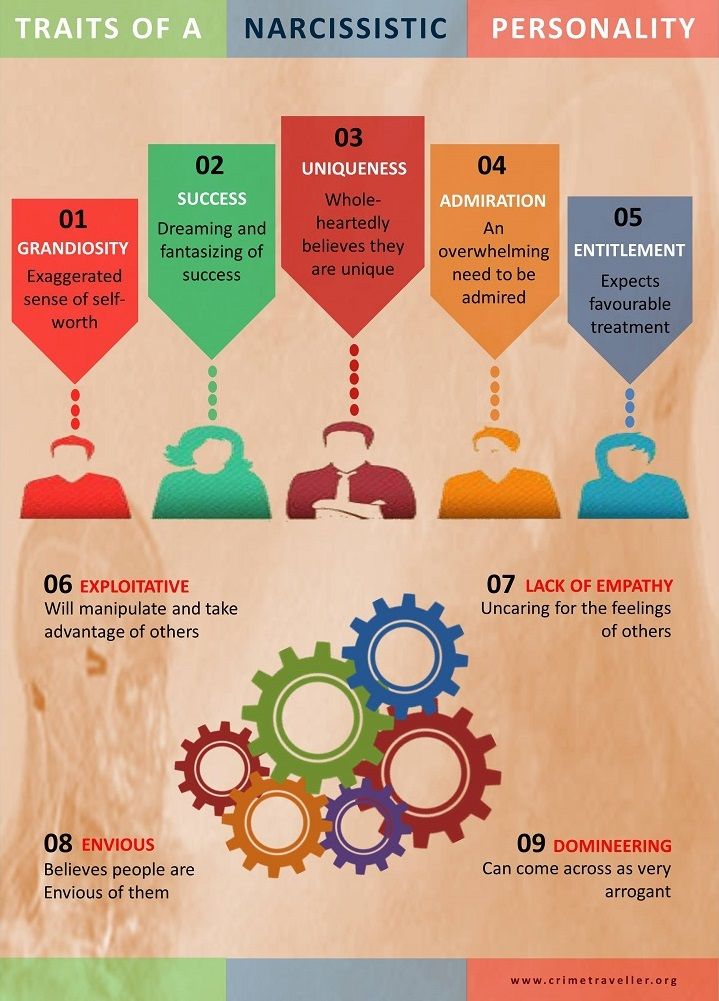
Risk factors
Although the precise cause of personality disorders is not known, certain factors seem to increase the risk of developing or triggering personality disorders, including:
- Family history of personality disorders or other mental illness
- Abusive, unstable or chaotic family life during childhood
- Being diagnosed with childhood conduct disorder
- Variations in brain chemistry and structure
Complications
Personality disorders can significantly disrupt the lives of both the affected person and those who care about that person. Personality disorders may cause problems with relationships, work or school, and can lead to social isolation or alcohol or drug abuse.
By Mayo Clinic Staff
Related
Associated Procedures
Products & Services
Personality disorder - causes, types, types, symptoms, signs, diagnosis (test), treatment
Features
Causes
Symptoms
Diagnosis
Treatment
Personality disorder, the causes of which are not always obvious, used to be called constitutional psychopathy. This is a mental disorder that accompanies a person throughout life. The main changes affect the character, thinking and behavior, which causes difficulties in social adaptation. The psychopath breaks the norms and rules accepted in the social environment. The severity of the changes is different - from everyday inconsistency to criminal acts with subsequent restriction of freedom.
This is a mental disorder that accompanies a person throughout life. The main changes affect the character, thinking and behavior, which causes difficulties in social adaptation. The psychopath breaks the norms and rules accepted in the social environment. The severity of the changes is different - from everyday inconsistency to criminal acts with subsequent restriction of freedom.
Features of personality disorder
World statistics of diseases states that about 10% of the world's population suffers from psychopathy. Each type of personality disorder accounts for an average of about 2% of cases. A distinctive feature is that the first manifestations are noticeable already in early childhood, practically unchanged throughout life.
Psychopathy is not quite a disease in the usual sense of the word. The disease has a beginning, progression and consequences in the form of organic (irreversible) disorders of the function and structure of organs.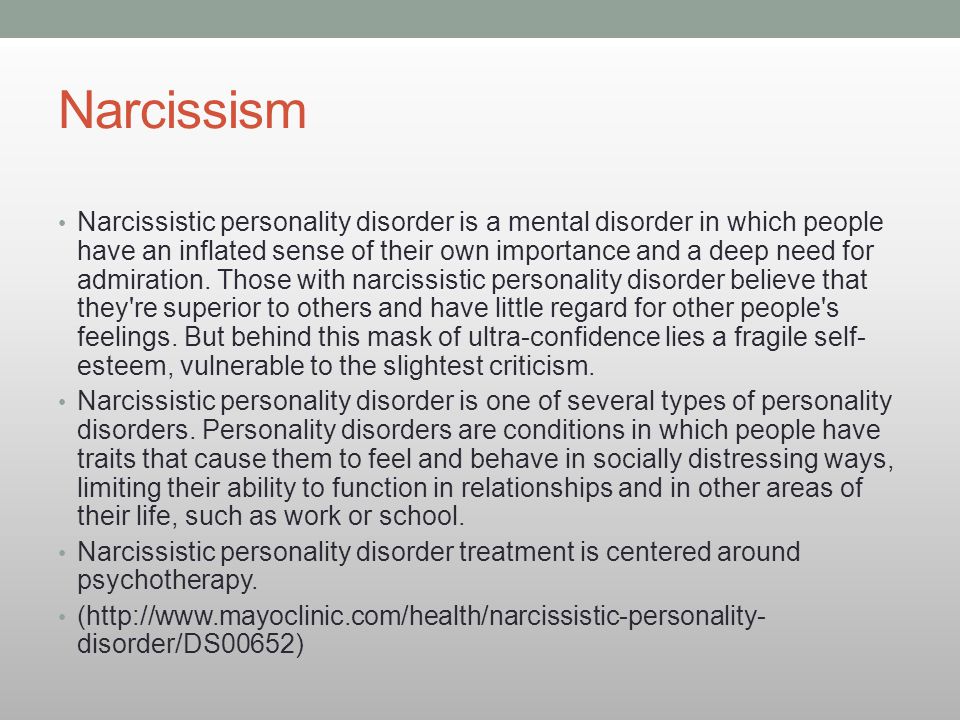 Psychopathy is a special, painful personality structure that does not undergo any changes in the changing conditions of life. This prevents the psychopath from adapting to the environment. Relatively speaking, a person with a personality disorder will behave in the same way with a first grader and a scientist, in a tram and a living room, not realizing that different people and situations require different behavior.
Psychopathy is a special, painful personality structure that does not undergo any changes in the changing conditions of life. This prevents the psychopath from adapting to the environment. Relatively speaking, a person with a personality disorder will behave in the same way with a first grader and a scientist, in a tram and a living room, not realizing that different people and situations require different behavior.
The problem of psychopathic personalities, anomalies of character was thoroughly studied by the Soviet and Russian psychiatrist Pyotr Borisovich Gannushkin, whose definitions of personality disorders have not lost their relevance to this day.
Causes of personality disorders
Experts consider several main reasons:
- genetic factor - practice shows that pathological character traits are found in representatives of different generations of the same family;
- an established vicious system of interpersonal relationships - the child does not have before his eyes an example of a normal, sympathetic and empathetic family;
- a psychopathic pattern (template, model) of behavior that the child unconsciously copies due to the lack of other examples;
- pathological pregnancy, difficult childbirth and diseases of early childhood;
- childhood abuse, physical or psychological;
- difficult childhood, unfavorable developmental conditions.

Researchers believe that genetic factors are of paramount, determining importance. This theory is confirmed by the twin method: identical brothers and sisters, separated in early childhood and raised in different families, behave exactly the same in adulthood. Twins who have never interacted with each other show the same types of personality disorder.
Personality disorder symptoms
Gannushkin identified 7 types of psychopathy. Since the 90s, when the 10th revision of the International Classification of Diseases, Injuries and Causes of Death came out, the condition has been called a personality disorder, but the essence has not changed. Each type of psychopathy has its own distinctive features.
Schizotypal personality disorder is distinguished by the minimization of social contacts, lack of need for communication, coldness, lack of empathy (the ability to empathize). Schizoids are attracted to fantasies, various distant theories, they are unable to perceive life directly, sensually.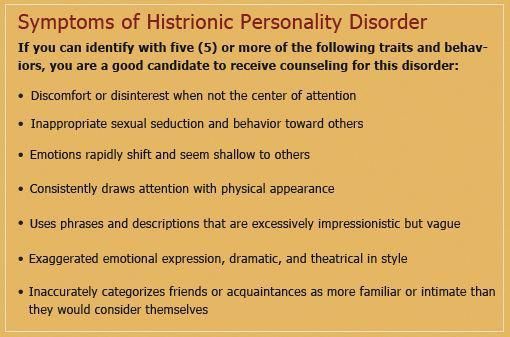 Teamwork is not for them, they can be more or less successful in individual activities. Their main feature is indifference, both to themselves and to others. Such people sincerely do not understand what pleasure and joy are, because they have never experienced them.
Teamwork is not for them, they can be more or less successful in individual activities. Their main feature is indifference, both to themselves and to others. Such people sincerely do not understand what pleasure and joy are, because they have never experienced them.
Bipolar personality disorder according to Gannushkin includes 3 types: depressive, agitated and cyclothymic. Depressives are lifelong pessimists who are able to see only sad, gloomy sides in all the diversity of life. Excited - easy-going, carried away, often unable to foresee the consequences of their actions. The vast majority of gamblers and swindlers are of this type. Cyclothymics combine both of the above features, they are characterized by undulating mood swings, lack of stable attachments, blurring and diversity of interests.
Dissociative identity disorder in Western culture is called a split identity. It is believed that several personalities coexist in one person, which are periodically activated.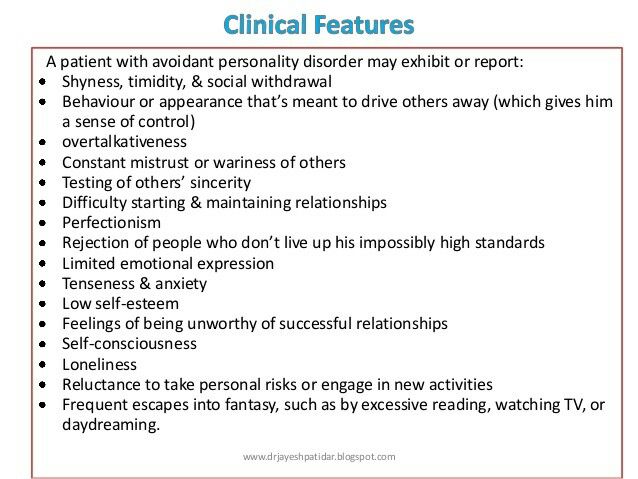 We have been using this diagnosis since 2000, but it does not take root well. Domestic psychiatrists consider this disorder a kind of psychological defense of a person who has experienced extreme, unbearably painful emotions. At the same time, a person perceives the events of his life as something that happened to others.
We have been using this diagnosis since 2000, but it does not take root well. Domestic psychiatrists consider this disorder a kind of psychological defense of a person who has experienced extreme, unbearably painful emotions. At the same time, a person perceives the events of his life as something that happened to others.
Narcissistic personality disorder refers to the Greek myth of Narcissus, a young man who preferred the love of a real girl to looking at his reflection in the water of a stream. Like the hero of a myth, a narcissist is convinced of his exclusivity and originality, and this applies to everything from appearance to achievements. The narcissist believes that real achievements are hindered by the envy of others who put up all sorts of obstacles. Own uniqueness requires constant confirmation, so the narcissist maintains relationships only with those who admire him.
Organic personality disorder - a consequence of damage to the brain tissue by various hazards: trauma, intoxication, infection.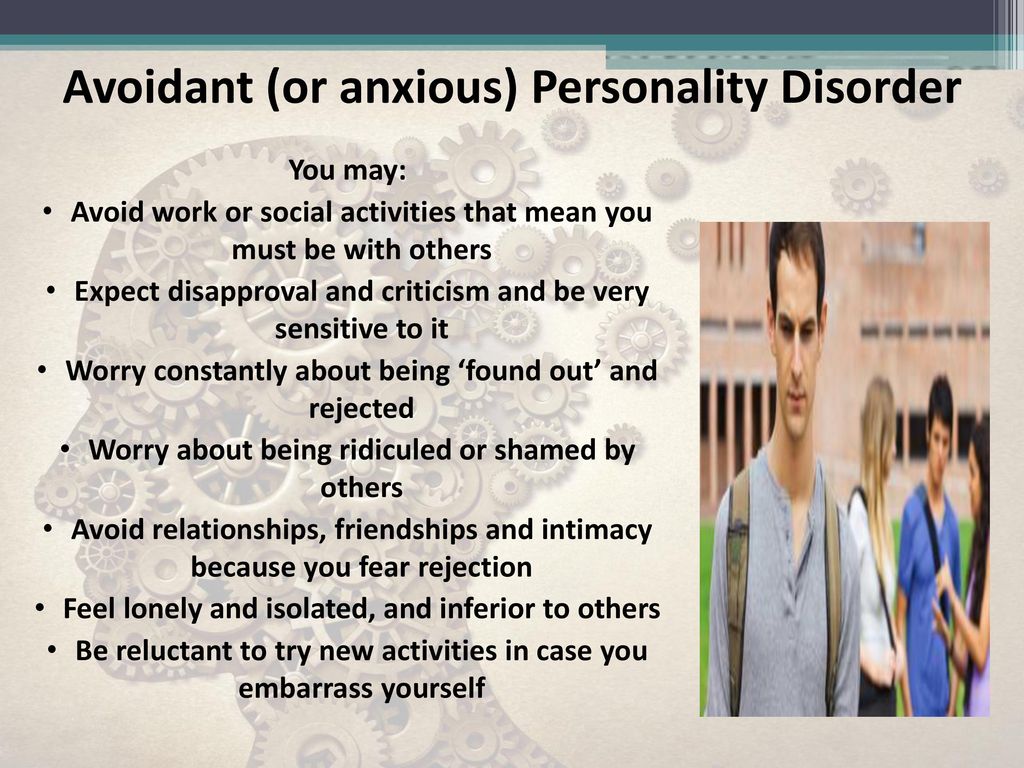 Such a disorder occurs in the clinic in patients who have had a stroke, encephalitis, in alcoholics and drug addicts. In the latter, the condition is aggravated by the consequences of closed craniocerebral injuries, which they receive when falling from a height of their own height in a state of intoxication.
Such a disorder occurs in the clinic in patients who have had a stroke, encephalitis, in alcoholics and drug addicts. In the latter, the condition is aggravated by the consequences of closed craniocerebral injuries, which they receive when falling from a height of their own height in a state of intoxication.
In a mild form of the disorder, the patient is disturbed by frequent headaches, weakness, fatigue, tearfulness, intolerance to stuffiness, meteorological dependence. Over time, thinking is disturbed, thoroughness, viscosity, concentration on minor details joins. Such a patient cannot separate the main from the secondary, speech becomes impoverished, emotions coarsen, periods of an evil-dreary mood (dysphoria) occur. An intellectual decline occurs, the patient cannot cope with the previous work, criminal episodes with fights and bodily injuries to the “offender” are not uncommon.
Borderline personality disorder is manifested by unstable mood, fluctuating from overestimation of oneself to humiliation.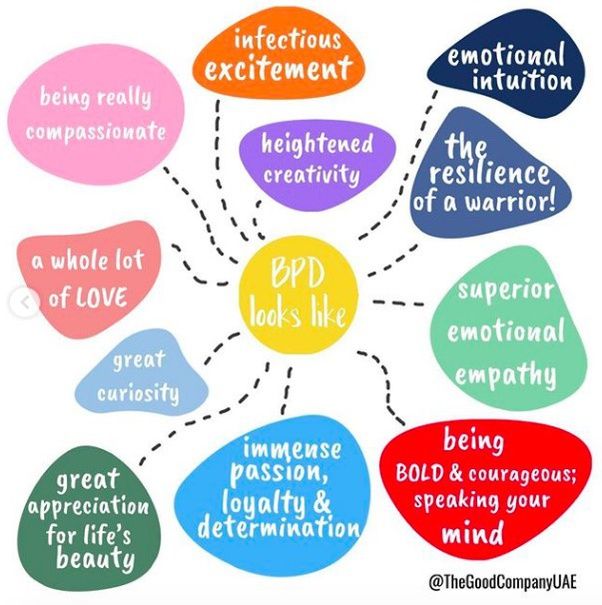 Patients are impulsive, commit rash acts, anxious, suicidal. Any little thing causes a feeling of emptiness, fears of being unnecessary, "thrown out of life." This disorder is the basis for the formation of drug addiction and eating disorders.
Patients are impulsive, commit rash acts, anxious, suicidal. Any little thing causes a feeling of emptiness, fears of being unnecessary, "thrown out of life." This disorder is the basis for the formation of drug addiction and eating disorders.
Personality disorder diagnostics
It is desirable to carry out such a diagnosis as early as possible, because the disorder accompanies a person all his life. Problem children should be under the supervision of a child psychiatrist in order to overcome teenage difficulties with minimal losses. Even a single consultation with a specialist will allow parents to correct the behavior of the baby, as they will understand the motives of his actions.
A variety of tests for personality disorder are used in adolescents and adults. Popular tests based on the work of Eysenck, Beck, Freeman. The test is a questionnaire with several standardized answers, a lie scale is provided so that the subject cannot be misled. The tests are fairly objective and are widely used in the clinic.
The tests are fairly objective and are widely used in the clinic.
Personality disorder treatment
The basis of treatment is the choice of a life path, profession and occupation suitable for the type of personality. This is where a clinical psychologist can help. An occupation corresponding to a personality type can make a person so successful that no one will notice the disorder.
In severe cases, when the time for professional orientation is missed, medications (antidepressants, tranquilizers, nootropics), psychotherapeutic methods, including psychoanalysis, are used. Treatment options for advanced personality disorders are limited, especially in patients with addiction or irreversible brain damage.
The best solution for suspected psychopathy is timely consultation with an experienced psychiatrist.
Article author:
Novikov Vladimir Sergeevich
psychotherapist, clinical psychologist, kmn, member of the Professional Psychotherapeutic League
reviews leave a review
Clinic m.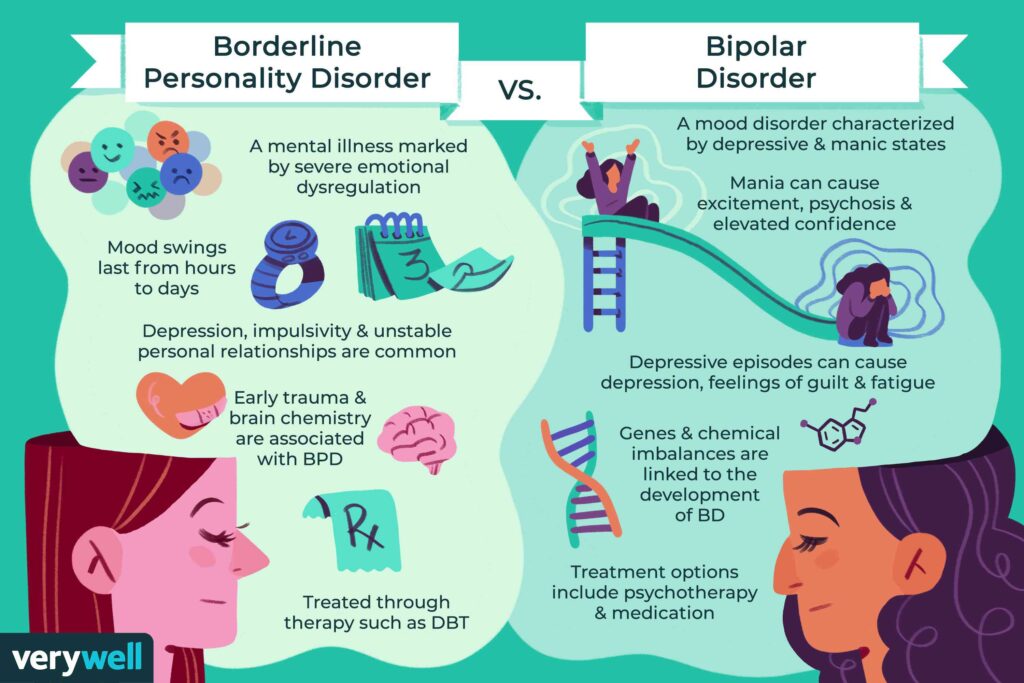 Frunzenskaya
Frunzenskaya
Reviews
Services
- Title
- Initial appointment, consultation with a psychotherapist (up to 1 hour) 4000
- Repeated appointment, consultation with a psychotherapist (up to 1 hour) 3000 905 years. Red Gates. AvtozavodskayaPharmacy. Glades. Sukharevskaya. st. Academician Yangelam. Frunzenskaya Zelenograd
Basko Marina Vladislavovna
psychotherapist
reviews Make an appointment
Clinic
m. Sukharevskaya
Sorokin Maxim Vladimirovich
psychotherapist
reviews Make an appointment
Clinic
m. Frunzenskaya
Types of personality disorders and features of their treatment. Paranoid, schizoid, dissocial, hysterical disorder, obsessive-compulsive, obsessive-compulsive, anxious, narcissistic
The main feature of personality disorders are pronounced maladaptive features of the psyche - such patients do not know how and cannot get along with others, adapt to new conditions.
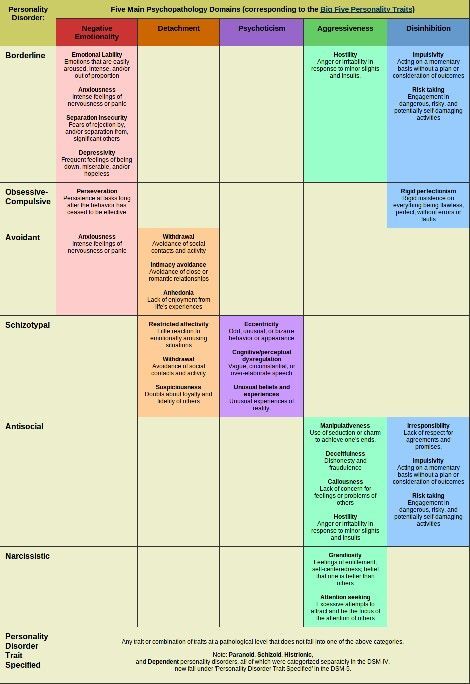 Previously, personality disorders were called psychopathy, but over time, experts adopted a Western point of view - psychopathy is still a separate mental disorder. There are several types of personality disorders, sometimes there are mixed types of the disease. Treatment should only be carried out by experienced professionals, but the main problem with this disorder is that patients for the most part do not recognize their mental problems.
Previously, personality disorders were called psychopathy, but over time, experts adopted a Western point of view - psychopathy is still a separate mental disorder. There are several types of personality disorders, sometimes there are mixed types of the disease. Treatment should only be carried out by experienced professionals, but the main problem with this disorder is that patients for the most part do not recognize their mental problems. Submit an application for diagnosis and treatment
I confirm that I accept the terms of consent to the processing of personal data.
Types of personality disorders and features of their treatment
Every fifteenth inhabitant of our planet suffers from a personality disorder. Moreover, he himself hardly perceives his condition as a disease that requires an appeal to specialists. He will justify all his actions and consider his behavior normal. Treatment denies, and the consequences are unpredictable.
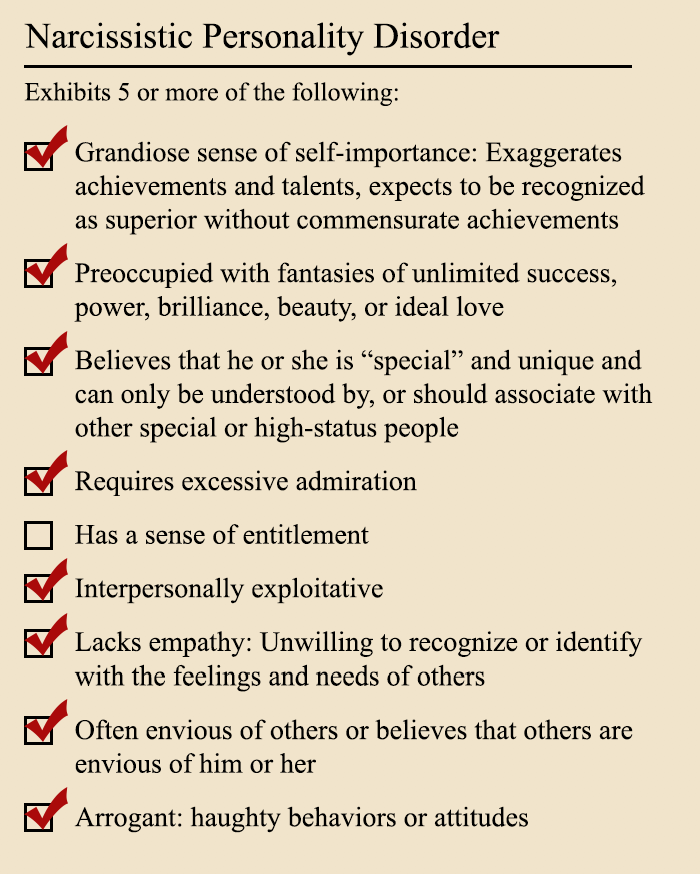
Personality disorder: adjustment difficulties
Personality disorder is a maladaptive pattern of behavior caused by a persistent mental disorder that is not associated with a physical or neurological disease. This pathology is difficult to correct, because the patient does not believe that he needs treatment. There is no motivation, which is a catalyst for positive changes. The individual himself does not seek to get rid of the violation and does not make good contact with psychotherapists. Late appeal to specialists leads to the fact that the patient gets an appointment with a psychiatrist already in the stage of deep neglect of the disease. It can be difficult to relieve symptoms and cure. The first signs of the disease are actively manifested in adolescence. Before this period, individual episodes are possible, but only after the period of puberty can we talk about the problem. Individuals with cognitive personality disorder do not understand why others talk about any of their problems.
 After all, they believe that behavior and actions are normal. People with personality disorders are poorly perceived in society. They often have difficulties in personal communication. But at the same time, patients do not feel pangs of remorse and have no sympathy for others. After a certain time, their relationship with the world is built not according to the principle of personal adaptation to society, but according to the scheme, when the society is forced to accept or not accept a problematic person. The lack of motivation and desire to be treated exacerbates the problem, since not every doctor can find an approach to such a patient, relieve the symptoms of exacerbation and help get rid of the problem.
After all, they believe that behavior and actions are normal. People with personality disorders are poorly perceived in society. They often have difficulties in personal communication. But at the same time, patients do not feel pangs of remorse and have no sympathy for others. After a certain time, their relationship with the world is built not according to the principle of personal adaptation to society, but according to the scheme, when the society is forced to accept or not accept a problematic person. The lack of motivation and desire to be treated exacerbates the problem, since not every doctor can find an approach to such a patient, relieve the symptoms of exacerbation and help get rid of the problem. Specific personality disorders
In Soviet times, overly emotional individuals were often called psychopaths. Such a characterization and classification was not inherent in Western psychiatry. Psychopathy is a serious violation of a behavioral nature, in which, against the background of underdevelopment of a number of personality traits, one clearly dominates.
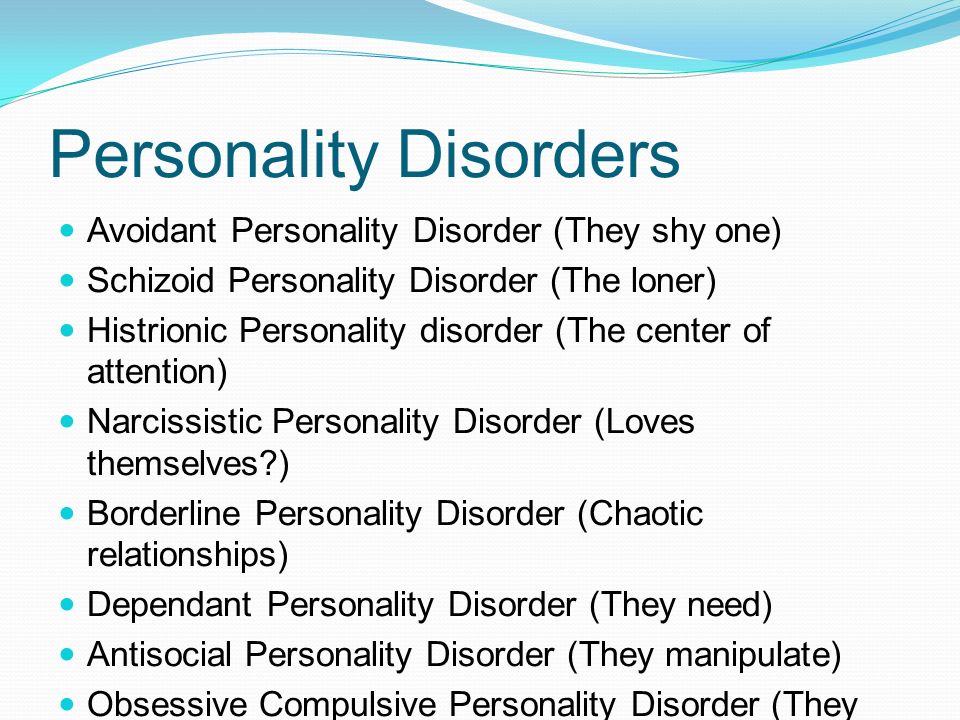 This includes a number of deviations. Types of personality disorders:
This includes a number of deviations. Types of personality disorders: - § Paranoid - the patient is dominated by overvalued ideas. He attaches special importance to his personality. But he treats others with hostility, suspecting them of malicious intent. A person with a pathology does not recognize its presence. When relatives or friends pay attention to a cognitive deviation and try to take him to a specialist, he will assure that everything is in order with him and deny the existence of a problem. Very sensitive to criticism.
- § Schizoid - this diagnosis is characterized by introversion, isolation, decreased interest in life's things. The patient does not perceive the accepted norms of social behavior, often behaves eccentrically. Schizoid personality disorders are associated with a great passion for some kind of activity in which the individual succeeds. For example, he may be pathologically addicted to various health systems, to the point of attracting other people to his interests.
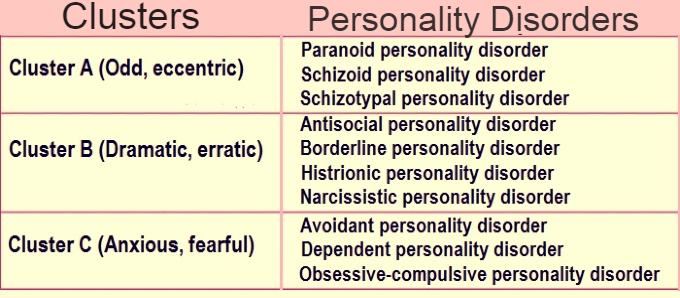 Experts believe that in this way a certain asociality is replaced. Also, such patients may have problems with alcohol, drugs or other types of addiction.
Experts believe that in this way a certain asociality is replaced. Also, such patients may have problems with alcohol, drugs or other types of addiction. - § Dissocial - a characteristic feature of such a personality disorder is the cognitive defiant behavior of the patient in order to obtain the desired. With all this, such patients are able to win over people, including doctors. This type is especially pronounced in late adolescence.
- § Hysterical - the main goal of such patients is to draw attention to their person in any way, including defiant behavior. The diagnosis is more typical for women. Atypical capriciousness, inconstancy of desires, extravagance, deceit are observed. In order to attract attention, the patient invents non-existent diseases for himself, the symptoms of which can be given out by the autonomic system and which is difficult to remove.
- § Obsessive-compulsive - patients with this type of personality disorder pathologically strive for order and perfection.
 They have no sense of humor, they try to be perfect in everything. When the set ideal goals are not achieved, they can fall into depressive states.
They have no sense of humor, they try to be perfect in everything. When the set ideal goals are not achieved, they can fall into depressive states. - § Anxiety - such a personality disorder is characterized by the cultivation of a personal inferiority complex. Patients are in a state of perpetual anxiety and uncertainty. From childhood, such patients are shy and timid. Often suspect others of hostility. They are prone to depression.
- § Narcissistic - a deviation in which a person manifests narcissism from childhood, a desire to be constantly admired. Such a patient does not accept criticism: he reacts to it either with resentment or with aggression. Indifferent to the feelings of other people, prone to exploiting them to achieve their own goals.
Different forms of psychopathy require an individual approach to treatment. Personality disorders should not be confused with character accentuation. In the latter case, a person also has behavioral features, but they lie within the upper limit of the norm.
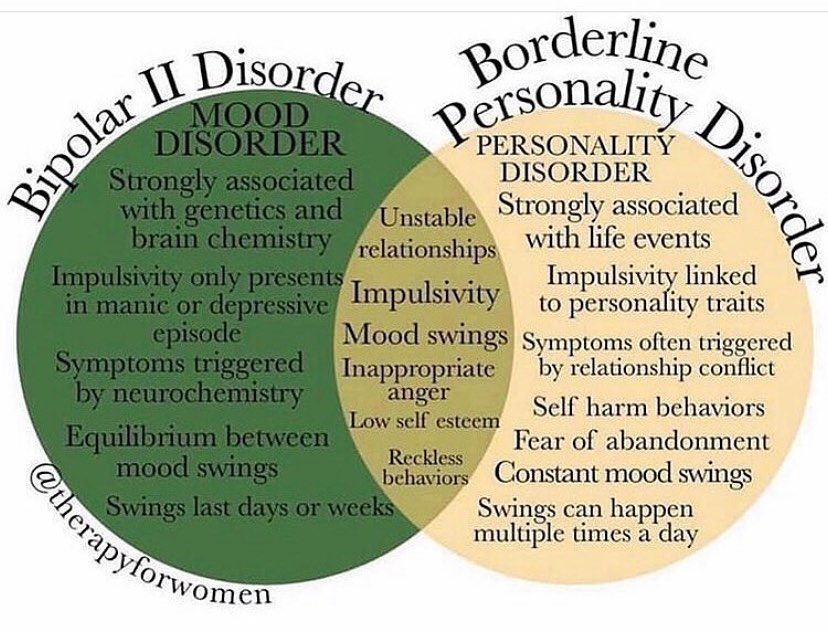 In addition, it is adapted to social conditions. The classification of classical psychopathy is inappropriate here. Diagnosis and types are different.
In addition, it is adapted to social conditions. The classification of classical psychopathy is inappropriate here. Diagnosis and types are different. Causes that cause personality and behavioral disorders
All specific personality disorders are usually divided into three clusters. Their classification:
- § Types of cluster A psychopathy: paranoid and schizoid;
- § Cluster B psychopathy: hysterical, asocial, narcissistic;
- § Types of cluster B psychopathy: obsessive-compulsive, depressive.
The causes of cluster A psychopathy are considered to be genetic and hereditary. The fact is that among the relatives of patients who have a personality disorder, as a rule, there is at least one with schizophrenia. A hereditary predisposition to pathologies can also be traced in cluster B and C psychopathy. The first option can also be aggravated by problems with alcohol: in families of people who drink, children often develop with disorders.
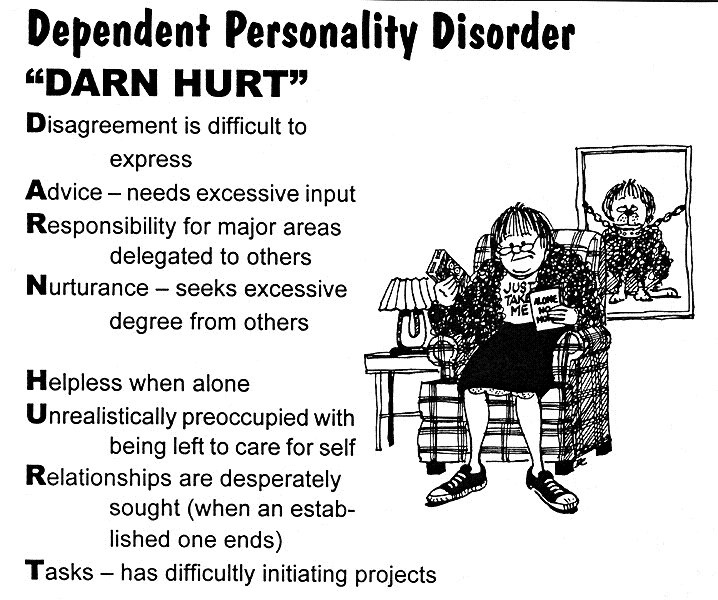 There is a version that cognitive specific personality disorders may be associated with hormonal disorders in the body. If a person has elevated levels of testosterone, estrone and estradiol, the consequences of this are manifested in the form of aggression. In addition, he does not produce enough endorphins, which, in turn, leads to depressive disorders. The social factor also plays an important role in the formation of the psychotype. For active children, space is important. If they are forced to be brought up in a closed space, small areas, this leads to the appearance of hyperactivity. Anxious babies from birth can become balanced if they are raised by emotionally stable parents. A calm mother can help a child become confident, and an anxious one can not remove, but increase his personal anxiety state. Character traits become noticeable already in early childhood. In adolescence, they can already develop as a personality disorder. Cognitive impairment is manifested in a decrease in memory, increased fatigue.
There is a version that cognitive specific personality disorders may be associated with hormonal disorders in the body. If a person has elevated levels of testosterone, estrone and estradiol, the consequences of this are manifested in the form of aggression. In addition, he does not produce enough endorphins, which, in turn, leads to depressive disorders. The social factor also plays an important role in the formation of the psychotype. For active children, space is important. If they are forced to be brought up in a closed space, small areas, this leads to the appearance of hyperactivity. Anxious babies from birth can become balanced if they are raised by emotionally stable parents. A calm mother can help a child become confident, and an anxious one can not remove, but increase his personal anxiety state. Character traits become noticeable already in early childhood. In adolescence, they can already develop as a personality disorder. Cognitive impairment is manifested in a decrease in memory, increased fatigue.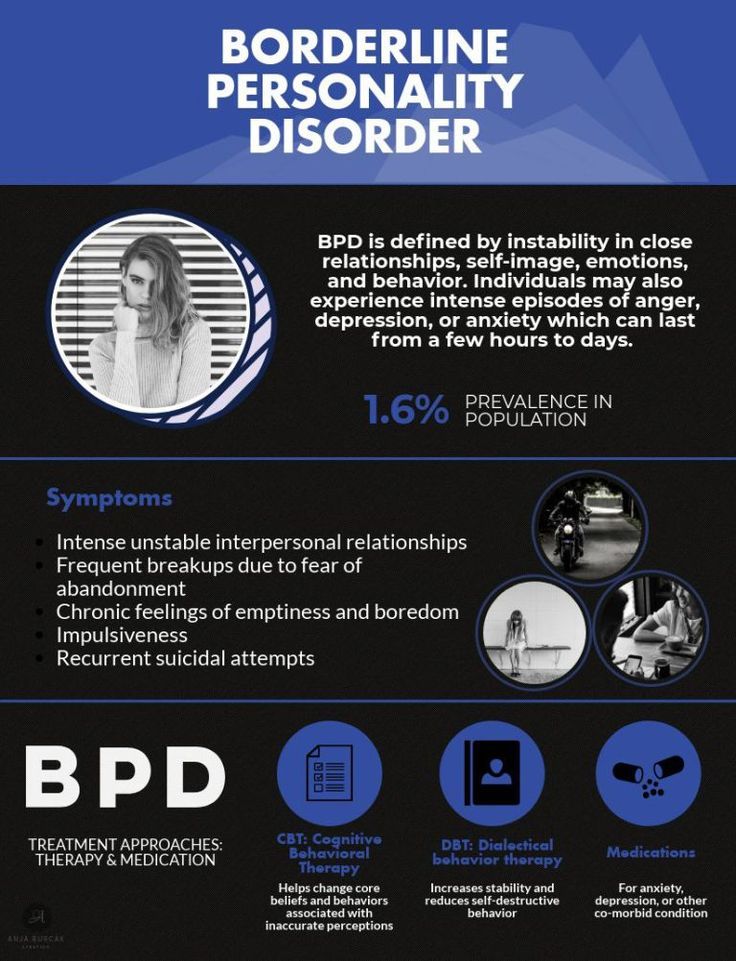 Pathologies of the nervous system are observed more often in people with an asocial temperament.
Pathologies of the nervous system are observed more often in people with an asocial temperament. Mixed personality disorder
This type of psychopathy is less studied than others. The classification has no special criteria. The patient manifests forms of one or the other type of disorders that are not persistent. Therefore, this type of disorder is also called mosaic psychopathy. But it is also difficult for a person with a mixed type of disorder to get along in society because of the peculiarities of their behavior. Instability of character is often the basis that contributes to the development of various types of addiction. Mixed personality disorder may be accompanied by alcoholism, drug addiction, gambling addiction. Mosaic psychopathy can combine symptoms of the schizoid and paranoid types. Such people do not know how to build social contacts in society, they are obsessed with overvalued ideas. With the predominance of paranoid symptoms, patients suffer from increased suspicion.
 They are prone to scandals, threats, like to write angry complaints about everyone and everything. Specialists are alarmed if signs (classification) of several disorders coexist in one patient: schizoid, hysterical, asthenic, excitable. In this case, there is a high risk of developing schizophrenia. Brain injuries or complications after a number of diseases can lead to mosaic types of pathology. This mixed personality disorder is considered acquired. If we consider the situation in detail, it will look like this: a person already has an innate tendency to mosaic psychopathy, which, due to certain circumstances, is superimposed by organic pathology. Mosaic disorder requires specific treatment only when symptoms worsen, or if there is organic build-up. Then neuroleptics, tranquilizers, vitamins can be prescribed by a specialist.
They are prone to scandals, threats, like to write angry complaints about everyone and everything. Specialists are alarmed if signs (classification) of several disorders coexist in one patient: schizoid, hysterical, asthenic, excitable. In this case, there is a high risk of developing schizophrenia. Brain injuries or complications after a number of diseases can lead to mosaic types of pathology. This mixed personality disorder is considered acquired. If we consider the situation in detail, it will look like this: a person already has an innate tendency to mosaic psychopathy, which, due to certain circumstances, is superimposed by organic pathology. Mosaic disorder requires specific treatment only when symptoms worsen, or if there is organic build-up. Then neuroleptics, tranquilizers, vitamins can be prescribed by a specialist. Infantile personality disorder
With this type of psychopathy, signs of social immaturity are pronounced. A person is not able to withstand stressful situations and relieve tension.
 In difficult circumstances, he does not control his emotions in the same way as children do. Infantile personality disorders for the first time clearly declare themselves in adolescence. Hormonal storms that occur at this time with a person cause changes in the psycho-emotional sphere. As you get older, the diagnosis can only progress. It is possible to finally talk about the presence of the disease only after reaching 16-17 years. In stressful circumstances, the patient manifests himself immature, poorly controls aggression, anxiety, fear. Such a person is not hired for military service, they are denied employment in law enforcement agencies. Permits to carry weapons or obtain a driver's license are decided on a limited and strictly case-by-case basis, according to an assessment of signs and condition.
In difficult circumstances, he does not control his emotions in the same way as children do. Infantile personality disorders for the first time clearly declare themselves in adolescence. Hormonal storms that occur at this time with a person cause changes in the psycho-emotional sphere. As you get older, the diagnosis can only progress. It is possible to finally talk about the presence of the disease only after reaching 16-17 years. In stressful circumstances, the patient manifests himself immature, poorly controls aggression, anxiety, fear. Such a person is not hired for military service, they are denied employment in law enforcement agencies. Permits to carry weapons or obtain a driver's license are decided on a limited and strictly case-by-case basis, according to an assessment of signs and condition. Transient personality disorder
This diagnosis refers to borderline conditions, when the symptoms of deviation are difficult to attribute to any type of personality disorder.
 The main causes of psychopathy are long-term stressful situations. In the modern world, a person is surrounded by many unfavorable factors: troubles at work, military operations, difficult family circumstances, financial failures, moving... All this disrupts the usual way of life and unbalances. If such circumstances last too long, the human psyche does not always have a reserve to survive and overcome them. Transient personality disorder has its own characteristics:
The main causes of psychopathy are long-term stressful situations. In the modern world, a person is surrounded by many unfavorable factors: troubles at work, military operations, difficult family circumstances, financial failures, moving... All this disrupts the usual way of life and unbalances. If such circumstances last too long, the human psyche does not always have a reserve to survive and overcome them. Transient personality disorder has its own characteristics: - § disorientation;
- § hallucinations;
- § nonsense;
- § inhibition of verbal and motor functions.
Even one of the symptoms can already signal a disorder. This diagnosis is special in that the disease does not last too long: sometimes only a day, and sometimes a month. It suddenly arises and just as it passes. Sometimes a person can go to sleep with a disturbance, and get up in a normal emotional state with residual effects in the form of increased anxiety or sleep disturbances.
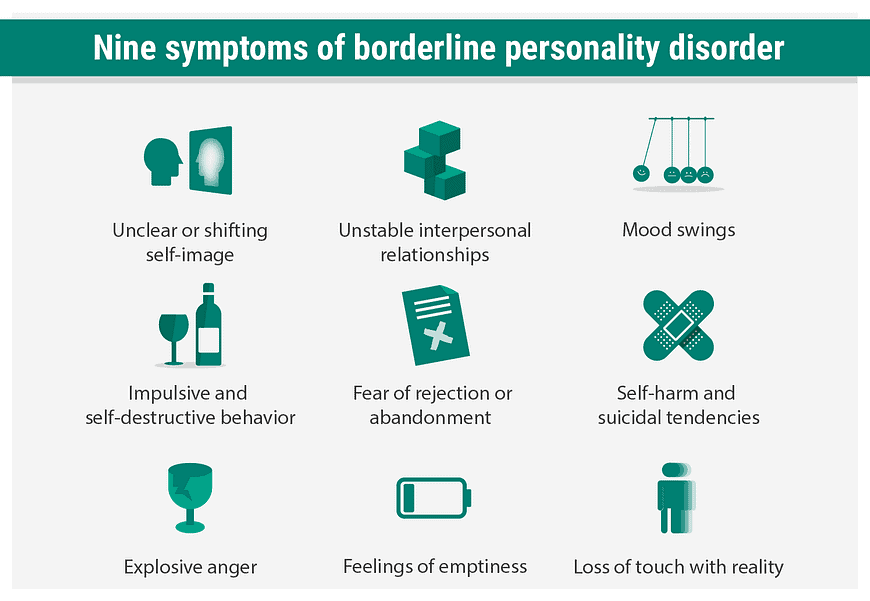 With each new stress, a spontaneous return of pathology is possible. Such a diagnosis does not pass without a trace. In the event that there are signs of delirium or hallucinations, such a person requires special treatment, because his condition can also threaten those around him. In the period between exacerbations, the patient experiences emotional burnout, in which nerve cells are also destroyed. Therefore, even for preventive purposes, it is recommended to take vitamins and herbal remedies. As historical examples show, partial transient personality disorder is not a benign condition. Many of the famous serial killers and maniacs had this diagnosis. They led a normal life, had families, work, but during the period of exacerbations they committed crimes. When Western experts studied the brains of executed criminals, they did not find significant changes in it. All its parts corresponded to the norm of a healthy person. And only stressful conditions could lead to the appearance of signs of a personality disorder, which entailed antisocial acts.
With each new stress, a spontaneous return of pathology is possible. Such a diagnosis does not pass without a trace. In the event that there are signs of delirium or hallucinations, such a person requires special treatment, because his condition can also threaten those around him. In the period between exacerbations, the patient experiences emotional burnout, in which nerve cells are also destroyed. Therefore, even for preventive purposes, it is recommended to take vitamins and herbal remedies. As historical examples show, partial transient personality disorder is not a benign condition. Many of the famous serial killers and maniacs had this diagnosis. They led a normal life, had families, work, but during the period of exacerbations they committed crimes. When Western experts studied the brains of executed criminals, they did not find significant changes in it. All its parts corresponded to the norm of a healthy person. And only stressful conditions could lead to the appearance of signs of a personality disorder, which entailed antisocial acts.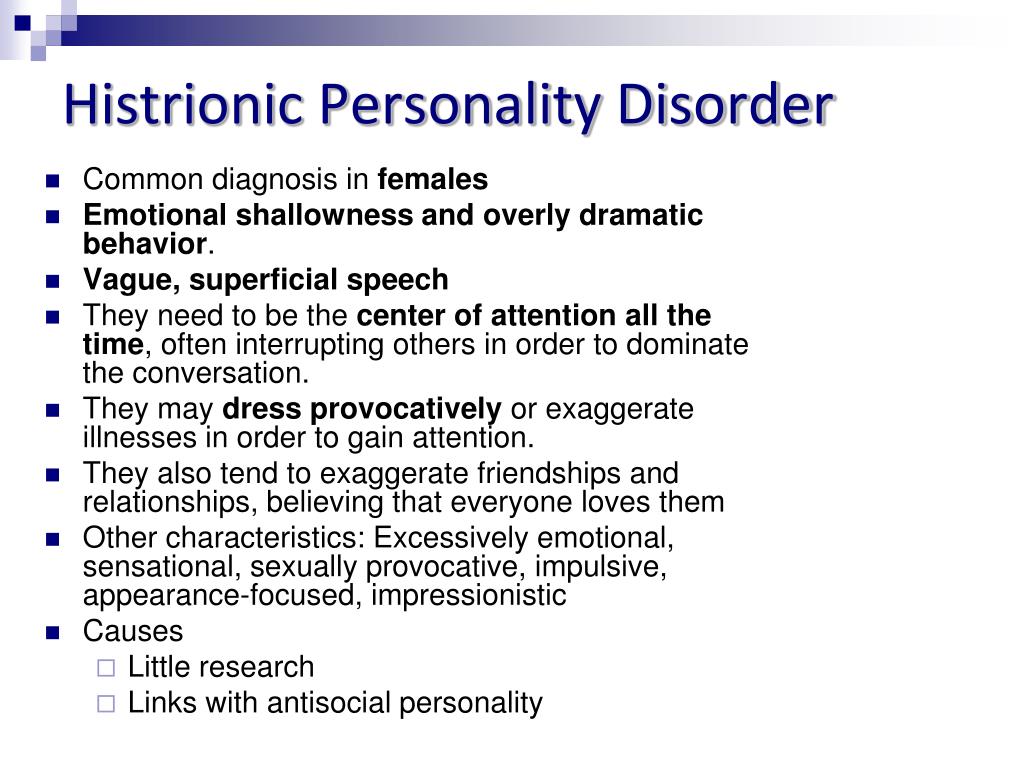 Perhaps, if during the period when the first signs of the disease appeared, there would have been a person nearby who noticed this and helped to contact a specialist, such consequences could have been avoided. Being face-to-face with continuous stressful situations, the psyche simply could not stand it. The mechanism of the development of the disease was launched.
Perhaps, if during the period when the first signs of the disease appeared, there would have been a person nearby who noticed this and helped to contact a specialist, such consequences could have been avoided. Being face-to-face with continuous stressful situations, the psyche simply could not stand it. The mechanism of the development of the disease was launched. Treatment for personality disorders
When a person is diagnosed with psychopathy, they rarely agree with it. The peculiarity of this disease is that the patient does not see problems in himself, but looks for them in others. Treatment in this case is always difficult. According to statistics, only one in five of them agree to accept help. Treatment of psychopathy is carried out individually. It includes sessions of psychotherapy and, if necessary, the use of drugs. In difficult cases, when the antisocial behavior of the patient poses a threat to others, treatment can be carried out in a hospital.
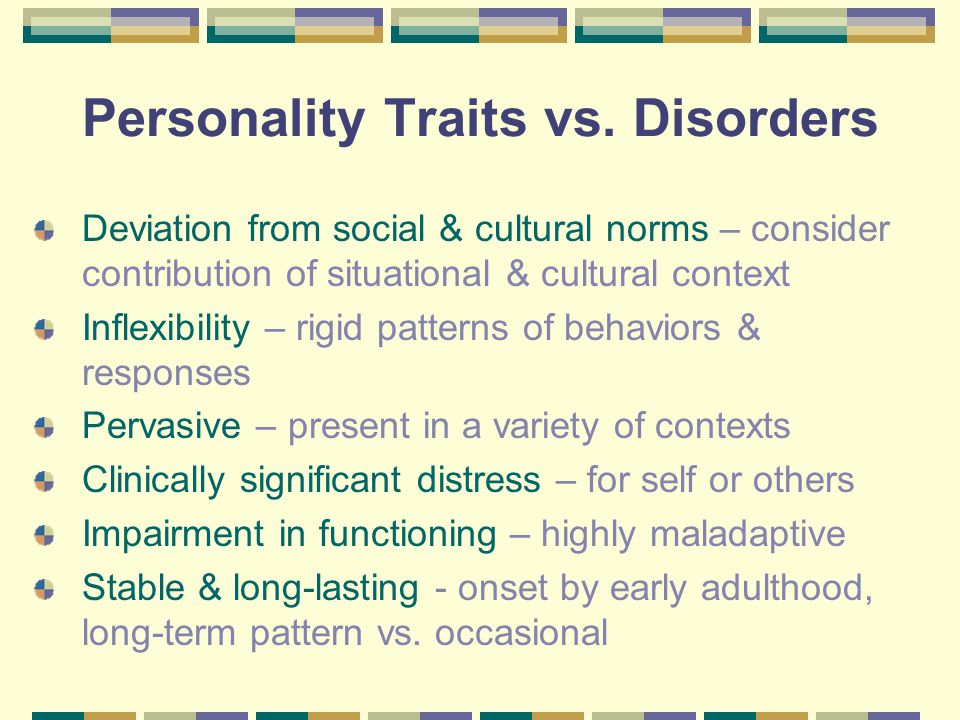
Learn more

